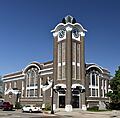Grand Haven Historic District facts for kids
Quick facts for kids |
|
|
Grand Haven Historic District
|
|

First Reformed Church
|
|
| Location | Washington Ave, adjacent Sts Harbor Dr. through 600 blocks, Grand Haven, Michigan |
|---|---|
| Architect | William G. Robinson, Frederick S. Robinson, Robinson & Campau, Christian W. Brandt, Harold D. Ilgenfritz, William M. Clarke, Pierre Lindhout, Smith, Hinchman & Grylls, Daverman Associates, Sidney J. Osgood, William A. Stone, Jr., William H. McCarty, Stone & Parent, Harold H. Fisher & Associates |
| Architectural style | Late Victorian, Romanesque Revival, Italianate, Queen Anne |
| NRHP reference No. | 16000584 |
| Added to NRHP | September 6, 2016 |
The Grand Haven Historic District is a special area in Grand Haven, Michigan. It includes many old shops and homes. This district is found along Washington Avenue and nearby streets. It goes from Harbor Drive up to the 600 block. This important area was added to the National Register of Historic Places in 2016. This means it's officially recognized for its history and unique buildings.
Contents
Grand Haven's Early Days
How Grand Haven Started
Grand Haven began as a fur trading spot in 1825. Real settlement started in 1835 when Rev. William M. Ferry arrived. A sawmill was also built there. One very old house, the Sidney Williams House, might be from the late 1830s.
As the lumber business grew, so did the town. By 1851, Grand Haven was big enough to have its own newspaper. The main shopping area quickly grew along Washington Avenue. It started near the harbor and spread out.
Fires and Rebuilding
Fires in 1853 and 1866 destroyed much of downtown. To prevent future damage, the city passed a rule in 1877. This rule said that new buildings in the main downtown area could not be made of wood. Some private homes from the 1850s and 1860s still stand. The oldest commercial building in the district was built around 1868.
New Industries and Growth
By the 1880s, the lumber boom was ending. But new businesses like fruit growing and shipping took its place. More brick buildings were built downtown. Building slowed down near the end of the century. This was partly because lumber jobs were gone.
In the early 1900s, Grand Haven found new ways to grow. More factories came to the city. A car ferry port also opened, which boosted shipping. Because of this, more buildings were built in the first ten years of the 1900s than any other time.
Grand Haven Through the Years
The city's population and the number of buildings kept growing. This continued through the 1920s and 1930s. Cars became popular, and tourism helped the city's economy. The Great Depression affected Grand Haven less than other places. Still, growth in the historic district slowed down.
Grand Haven kept growing after World War II. Many new buildings were constructed. They often replaced older ones that had been torn down. Today, Grand Haven is a popular vacation spot. Its historic downtown adds to its charm. New buildings are still being added. However, some newer ones are larger and don't always match the older styles.
Exploring the Historic District
What You'll See
The Grand Haven Historic District covers six blocks of Washington Street. This is the city's main business area. It also includes nearby streets with important buildings. You'll find the city hall, a former police and fire station, and churches. Many large homes are also here. Some of these old homes are now used as businesses.
The district also has the big Story & Clark Piano Company complex. You can also see early wooden commercial buildings on Third Street.
Buildings and Styles
The district has 121 buildings in total. Most are two stories tall. They were built between about 1840 and 1965. However, most were built in the late 1800s and early 1900s. The city's Central Park is also part of the district. Eighty-five of these properties, including the park, are considered historic.
You'll see many different building styles here. There are many Late Victorian commercial buildings. You can also find a movie theater from the Period Revival style. There's a former bank in the Neoclassical style. Homes include Italianate and Queen Anne designs. Some newer buildings are in the International and Mid-Century Modern styles.
Famous Buildings to Spot
Here are some notable buildings in the district:
- Nathaniel Robbins House (1899): This house at 20 South 5th Street was built for Nathaniel and Esther Robbins. Nathaniel was a successful businessman.
- Willard C. Shelden House (1893): This impressive house at 321 Washington is a beautiful example of the Queen Anne style. It was designed for Willard C. Shelden, who owned a spa.
- First Reformed Church (1913): This church at 301 Washington has a unique style. It mixes old Neoclassic ideas with an Arts and Crafts feel.
- Grand Theater lobby (1927): The lobby of this theater at 22 Washington was designed by Christian W. Brandt and Harold D. Ilgenfritz. Even though the main theater was torn down in 2004, the front and lobby were saved.
- Michigan Bell Telephone Building (1928): This three-story building at 501 Washington was designed by Smith, Hinchman & Grylls. It's made of brick and has a Colonial style.
- City Hall (1934): Located at 519 Washington, this building was designed by Robinson and Campau. It's a two-story Colonial building with a grand entrance.
- Police and Fire Department Building (1935): Also designed by Robinson and Campau, this building is at 18-20 North Fifth. It's a brick Colonial Revival building. A newer part was added in 1975.
- First Presbyterian Church (1954): This church at 508 Franklin was designed by Harold H. Fisher & Associates. It's made of orange brick with limestone trim.
Images for kids




